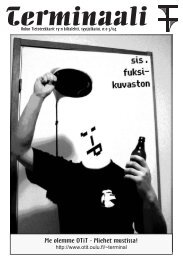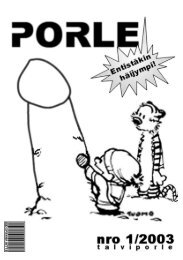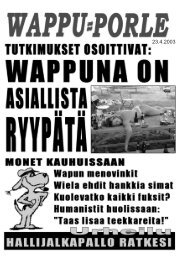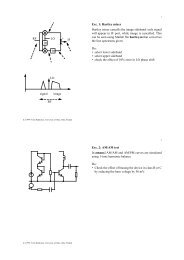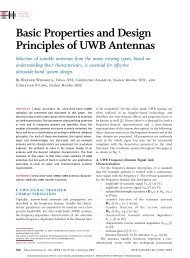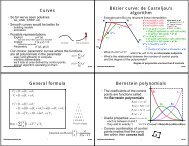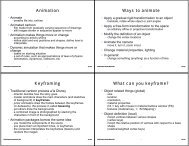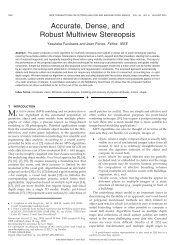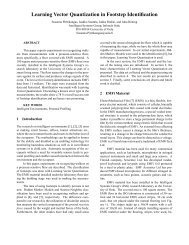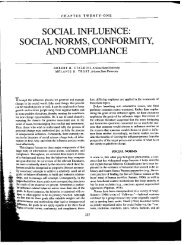On the Effect of Radio Channel Propagation Models - Oulu
On the Effect of Radio Channel Propagation Models - Oulu
On the Effect of Radio Channel Propagation Models - Oulu
You also want an ePaper? Increase the reach of your titles
YUMPU automatically turns print PDFs into web optimized ePapers that Google loves.
ON THE EFFECT OF RADIO CHANNEL PROPAGATION MODELS<br />
TO THE AD HOC NETWORK PERFORMANCE<br />
Jarmo Prokkola<br />
VTT Technical Research Centre <strong>of</strong> Finland,<br />
<strong>Oulu</strong>, Finland<br />
ABSTRACT<br />
In this paper we study <strong>the</strong> behavior <strong>of</strong>ad hoc network performance<br />
under different propagation models. Ad hoc networks<br />
are <strong>of</strong>ten studied with unrealistic cut propagation<br />
models, where <strong>the</strong> propagating signal is completely cut to<br />
some predefined distance. The worst drawback in this kind<br />
modeling is that it fails to include <strong>the</strong> effect <strong>of</strong> multiple access<br />
interference (MAI). Since cut propagation model is<br />
taken as a point <strong>of</strong> comparison, free space propagation<br />
model will provide <strong>the</strong> simplest enhancement to enable<br />
realistic MAI calculation. In addition, we also use a forest<br />
propagation loss model, which provides a more realistic<br />
environment for military scenarios. We study <strong>the</strong> performance<br />
in two cases. nodes equipped with our BCCA (Bi-<br />
Code <strong>Channel</strong> Access) and BC-MAC (Bi-Code MAC), and<br />
nodes with IEEE 802.11.<br />
The study shows that <strong>the</strong>re are significant differences in<br />
<strong>the</strong> absolute performance between scenarios with different<br />
propagation models. This clearly shows <strong>the</strong> importance <strong>of</strong><br />
lower layer modeling, although <strong>the</strong> focus would be on <strong>the</strong><br />
upper layer performance (e.g., on <strong>the</strong> application layer<br />
Quality <strong>of</strong> Service (QoS)). The study also shows that BC-<br />
MAC outperforms IEEE 802.11 regardless <strong>of</strong> <strong>the</strong> propagation<br />
modeling. Despite <strong>the</strong> fact that <strong>the</strong> ranking <strong>of</strong> <strong>the</strong> performance<br />
between BC-MAC and 802.11 was unchanged in<br />
this study, <strong>the</strong> great differences in <strong>the</strong> absolute performance<br />
questions <strong>the</strong> generality <strong>of</strong> <strong>the</strong> results obtained with<br />
simplified lower layer models. This should be taken into<br />
consideration especially in military related studies, where<br />
<strong>the</strong> focus <strong>of</strong>ten is in <strong>the</strong> absolute performance <strong>of</strong> a certain<br />
scenario and not only in <strong>the</strong> relative difference between<br />
some methods.<br />
INTRODUCTION<br />
In this study, we focus on <strong>the</strong> effect <strong>of</strong> radio signal propagation<br />
modeling to <strong>the</strong> performance <strong>of</strong> ad hoc networks.<br />
<strong>Propagation</strong> modeling has been studied a lot, but modeling<br />
in network level simulations, and especially in <strong>the</strong> case <strong>of</strong><br />
ad hoc networks, has been imperfect. Many <strong>of</strong> <strong>the</strong> studies<br />
so far use unrealistic cut radio channel model, which fails<br />
to model multiple access interference. Yet, some studies<br />
1 <strong>of</strong> 7<br />
Timo Braysy and Teemu Vanninen<br />
Centre for Wireless Communications (CWC),<br />
University <strong>of</strong> <strong>Oulu</strong>, <strong>Oulu</strong>, Finland<br />
for considering <strong>the</strong> importance <strong>of</strong> realistic physical layer<br />
in design <strong>of</strong> ad hoc network routing protocols has been<br />
addressed (e.g., [1]). In [2], for example, a shadowing<br />
model is used in ad hoc network simulations. The fluctuations<br />
in signals strength causes route breakages,<br />
which in turn lead to decreased packet delivery ratio,<br />
increased control traffic and increased packet delay that<br />
cause user perceived QoS to be decreased.<br />
<strong>On</strong>ly few papers address <strong>the</strong> effect <strong>of</strong> physical layer parameters<br />
to <strong>the</strong> performance <strong>of</strong> routing and MAC layer<br />
functions in wireless ad hoc networks. In [3], a simulation<br />
modeling study has been performed to demonstrate<br />
<strong>the</strong> possibly significant effect <strong>of</strong> <strong>the</strong> different physical<br />
layer properties such as physical layer preamble length,<br />
interference, fading and path loss. The study also addresses<br />
<strong>the</strong> importance <strong>of</strong> MAI calculation and discusses<br />
about <strong>the</strong> ways how different simulation tools model <strong>the</strong><br />
radio channel properties. In [4] and [5] a sophisticated<br />
indoor wireless channel model based on ray-tracing and<br />
Markov chains is presented and developed for NS-2<br />
simulation tool.<br />
The novelty in our paper is <strong>the</strong> extensive simulation<br />
study <strong>of</strong> propagation modeling impacts to <strong>the</strong> higher<br />
layer performance. We have set <strong>the</strong> parameters (e.g.,<br />
transmission power) in a way that <strong>the</strong> results <strong>of</strong> different<br />
scenarios are easily comparable to each o<strong>the</strong>r. The models<br />
used here are: free space propagation loss (FSL), forest<br />
propagation loss (FPL), and two cut propagation (CP)<br />
models, CP-LP (low power) and CP-HP (high power).<br />
CP-HP is a good point <strong>of</strong> comparison, since it is quite<br />
similar to <strong>the</strong> simplified radio channel models used in<br />
several studies. We use mainly our BCCA method and<br />
BC-MAC, but also IEEE 802.11 is used as a reference,<br />
since one <strong>of</strong> <strong>the</strong> goals is to compare BC-MAC and<br />
802.1 1 under different propagation models.<br />
SYSTEM DESCRIPTION<br />
A. BCCA and BC-MAC<br />
Bi-Code <strong>Channel</strong> Access (BCCA) is a dual channel access<br />
method designed especially for <strong>the</strong> needs <strong>of</strong> ad hoc<br />
networking. The basic idea is that <strong>the</strong> ad hoc nodes are
able to track two separate channels simultaneously. In our<br />
spread spectrum approach, nodes are able to track transmissions<br />
with two different spreading codes. <strong>On</strong>e is a<br />
common code channel (C-code), which is used for route<br />
maintenance and broadcast communications. The o<strong>the</strong>r is a<br />
receiver based code channel (R-code), which is unique for<br />
each node, unlike <strong>the</strong> C-code. R-code is used for all directed<br />
transmission (e.g., data) per hop basis. [6]<br />
Since BCCA is a channel access method to enable distributed<br />
CDMA-like (Code Division Multiple Access) communications<br />
for ad hoc networks, a medium access control<br />
(MAC) method is also needed. BC-MAC is designed to be<br />
used with BCCA. It is a straightforward CSMA-based<br />
(Carrier Sense Multiple Access) MAC solution with fast<br />
ARQ (Automatic Repeat Request) implementation. BC-<br />
MAC with BCCA has been shown to have very high performance<br />
in ad hoc environment. [7]<br />
With <strong>the</strong> use <strong>of</strong> BCCA, it is required that <strong>the</strong> R-type<br />
spreading codes <strong>of</strong> <strong>the</strong> nodes are known, For <strong>the</strong> cases<br />
where <strong>the</strong> codes are unknown, an efficient network layer<br />
spreading code distribution method is being developed.<br />
However, we will use <strong>the</strong> assumption <strong>of</strong> known codes in<br />
this paper, since it is a fair assumption in military scenarios.<br />
Hereafter, when we refer to BC-MAC, it is assumed<br />
that BCCA functionality is also implemented to it.<br />
B. IEEE 802.11<br />
The basic IEEE 802.11 (later referred to as 802.11) is considered<br />
as a point <strong>of</strong> comparison. The modeling <strong>of</strong> 802.11<br />
is based on <strong>the</strong> basic OPNET model <strong>of</strong> 802.11 with some<br />
modifications to enable <strong>the</strong> functionality with <strong>the</strong> used<br />
routing protocol (as in our previous studies [6], [7]). Some<br />
modifications were also needed to enable <strong>the</strong> possibility to<br />
use different propagation models, but no functional<br />
changes to <strong>the</strong> MAC have been made.<br />
The DSSS (Direct Sequence Spread Spectrum) mode <strong>of</strong><br />
802.11 is used, since DS spreading is also used in BC-<br />
MAC. Virtual carrier sensing is not used, because it produces<br />
additional overhead [8], which is not desired (multiple<br />
handshaking transmissions, latency, capacity decrement<br />
under heavy traffic). Carrier sensing is done by<br />
power level measurement with a threshold in both 802.11<br />
and BC-MAC. This threshold is set according to <strong>the</strong> power<br />
level, where <strong>the</strong> reception is just more likely to succeed<br />
than fail in <strong>the</strong>ory.<br />
C. The Physical Layer<br />
At <strong>the</strong> physical layer, channel data rate is set to 1 Mbit/s.<br />
To allow potentiality for interference suppression and to<br />
enhance LPD (Low Probability <strong>of</strong> Detection) and LPI<br />
(Low Probability <strong>of</strong> Interception) properties, sufficient<br />
2 <strong>of</strong> 7<br />
spreading factor is needed. Spreading code length <strong>of</strong> Nc<br />
= 63 chip is used. With bit-wise spreading, processing<br />
gain is directly 63 (- 18.0 dB). To make fair comparisons<br />
between BC-MAC and 802.11, <strong>the</strong> same spreading<br />
factor is also set to 802.11 instead <strong>of</strong> <strong>the</strong> standard value<br />
<strong>of</strong> 11. The frame formats are set to be equal according to<br />
- 802.11. The systems operate on 2.4 GHz ISM (Industrial,<br />
Scientific and Medical) frequency band.<br />
B. The Network Layer<br />
The network layer functionality is kept simple enough so<br />
that it does not provide any extra effects to <strong>the</strong> results.<br />
The functionality is mainly under control <strong>of</strong> Ad hoc <strong>On</strong>demand<br />
Distance Vector (AODV) routing protocol with<br />
some basic characteristics <strong>of</strong> IP (Internet Protocol). But<br />
for example address resolution protocol (ARP) is not<br />
used, instead, it is assumed for simplicity, that <strong>the</strong> MAC<br />
and network layer share <strong>the</strong> same address base.<br />
AODV is a reactive pure on-demand type routing protocol,<br />
where routes are formed and updated only when<br />
needed [9]. The used OPNET model <strong>of</strong> AODV is <strong>the</strong><br />
same as in our previous work (e.g., [6], where it is also<br />
described how to enable BCCA functionality with<br />
AODV). AODV hello-messages and passive listening at<br />
MAC layer are not used, because in military scenario,<br />
we want to avoid extra control traffic<br />
C. Transport & Application Layer<br />
In order to keep <strong>the</strong> focus on lower layer functionalities,<br />
it is not desired that <strong>the</strong> upper layers will add complexity<br />
and more parameters to <strong>the</strong> currently already quite large<br />
set <strong>of</strong> parameters. Thus, transport layer functionalities<br />
are minimized and <strong>the</strong> layer above network layer is basically<br />
<strong>the</strong> application layer. In a sense, <strong>the</strong> transport layer<br />
can be assumed to exist as UDP-lite (Lightweight User<br />
Datagram Protocol, [10]), if one assumes that <strong>the</strong> UDP<br />
fields exist in <strong>the</strong> data packet.<br />
Application layer is modeled statistically with traffic<br />
models. VBR-M [6] model is used as a traffic model,<br />
and <strong>the</strong> data packet length has a constant value <strong>of</strong> 4096<br />
bits. Because <strong>the</strong> focus is on lower layer functionalities,<br />
heavy tailed modern data traffic models are not used,<br />
since <strong>the</strong>y also introduce <strong>the</strong>ir own effects to <strong>the</strong> network<br />
performance (e.g., [11]). As a session model, dynamic<br />
connections are used [7].<br />
E. Simulation Scenarios and performance metrics<br />
This study is based on OPNET simulations. A basic ad<br />
hoc scenario is chosen, where <strong>the</strong> operational area has a<br />
size <strong>of</strong> 1500 m x 300 m and <strong>the</strong> nodes have effective<br />
radio range <strong>of</strong> about 250 m. The area contains 50 nodes,<br />
<strong>of</strong> which 20 run applications (i.e., generate traffic), but
all <strong>the</strong> nodes can receive data and route traffic. The simulated<br />
results are each averaged over 32 iterations, which<br />
each have 93750 simulated packets in average. The results<br />
are presented as a function <strong>of</strong> <strong>of</strong>fered data traffic load,<br />
which is normalized to <strong>the</strong> channel bit rate. Offered data<br />
traffic load is controlled by modifying mean interarrival<br />
time <strong>of</strong> data packets.<br />
Unfortunately we do not have enough space in this paper<br />
to consider both mobile and static nodes. We focus only on<br />
static nodes (which could form e.g., a military sensor network).<br />
In this way we can get more information about <strong>the</strong><br />
effect <strong>of</strong> lower layer modeling, since mobility would also<br />
bring its own features to <strong>the</strong> results. Static nodes here imply<br />
that <strong>the</strong> positions <strong>of</strong> <strong>the</strong> nodes are fixed to random locations<br />
in <strong>the</strong> beginning <strong>of</strong> each simulation iteration.<br />
Hence, <strong>the</strong> effect <strong>of</strong> node locations will be averaged over<br />
<strong>the</strong> simulated iterations. Certainly, it would be also interesting<br />
to see <strong>the</strong> effect <strong>of</strong> propagation modeling in <strong>the</strong> case<br />
<strong>of</strong> mobile nodes. It is, however, presumable that relative<br />
effect <strong>of</strong> propagation modeling would be similar to <strong>the</strong><br />
case <strong>of</strong> mobile nodes as it is for static nodes. AODV active<br />
route timeout is now set to infinity, since <strong>the</strong> topology does<br />
not change.<br />
ON THE RADIO CHANNEL MODELING<br />
A. <strong>Radio</strong> <strong>Channel</strong> and <strong>Propagation</strong> Modeling<br />
In ad hoc network studies, a cut propagation model is <strong>of</strong>ten<br />
used (e.g., [12], [13]). In this, <strong>the</strong> signal propagates according<br />
to some law to a certain distance, where <strong>the</strong> signal is<br />
simply cut (also referred as unit disk graph (UDG) model<br />
[1]). This distance is, <strong>the</strong>refore, <strong>the</strong> radio range <strong>of</strong> <strong>the</strong><br />
node. In <strong>the</strong> even more simplified cut model, no actual<br />
power attenuation is calculated, but <strong>the</strong> signal just arrives<br />
to <strong>the</strong> receiver inside certain radius around <strong>the</strong> node.<br />
Free space loss can be considered as a basic type <strong>of</strong> a real<br />
attenuation. It originates from <strong>the</strong> fact that <strong>the</strong> signal energy<br />
spreads over space in three dimensions as <strong>the</strong> propagation<br />
distance increases. The forest propagation loss<br />
(FPL) model used in this study is a combination <strong>of</strong> three<br />
commonly known models: free space, plane earth and<br />
Weissberger foliage attenuation models. The method is <strong>the</strong><br />
same as used in <strong>the</strong> OPNET Path Attenuation Routine<br />
(OPAR) by Mitre Corporation [14]. This model gives attenuation<br />
in leaf-tree forest, presumably fitting well to forest-like<br />
battlefields. At first, in <strong>the</strong> FPL model, both free<br />
space and plane earth attenuations are calculated as<br />
LPE = 40 logl0(D) -20 logl0 (hJX -20 logl0(hrx), (1)<br />
Lfs = 32.45 + 201oglo (D) + 20 1log, (f), (2)<br />
3 <strong>of</strong> 7<br />
where LPE= attenuation by plane-earth model (in dB),<br />
D = total path length (in meters), h,t, hrx = transmit and<br />
receiver antenna heights (in meters), respectively, Lf, =<br />
attenuation by free space model (in dB), f = frequency<br />
(in GHz). Using Weissberger model for foliage obstruction<br />
block, <strong>the</strong> actual foliage attenuation (in dB) is<br />
1l.33f0284 xD 0588, D1 >14m<br />
weiss O.45f 0284 XDjf0, O
transmission power for desired range when <strong>the</strong> path-loss<br />
model and all <strong>the</strong> signal losses are known (in reality this<br />
would be just estimation). When <strong>the</strong> receiver bandwidth<br />
(B) is 63 MHz and <strong>the</strong> receiver effective noise temperature<br />
(T) is 290 K, <strong>the</strong> noise power can be calculated as<br />
PN = kTB 1.379 .23290K 63 106Hz<br />
2.519e-3W<br />
where k is <strong>the</strong> Boltzmann's constant. Thus, <strong>the</strong> received<br />
power requirement is<br />
PRX = YbPN 2.30 -2.519 -10 W -92 dBm (6)<br />
Taking into account <strong>the</strong> 18 dB processing gain, <strong>the</strong> PRX<br />
drops to about -110 dBm.<br />
With FPL we get path loss for 250 m to be 132.12 dB<br />
when h,t and hrx are assumed to be 2 m andfis 2.4315 GHz<br />
in <strong>the</strong> ISM band. Since antennas are omnidirectional, antenna<br />
gains are 0 dB, <strong>the</strong> transmitted power should<br />
be PTX = PX /LWfe =0. 15 W . In <strong>the</strong> case <strong>of</strong> FSL, <strong>the</strong> path loss<br />
for 250 m is 88.13 dB and <strong>the</strong> corresponding PTX should be<br />
6 [tW. As a point <strong>of</strong> comparison, we take two cut propagation<br />
models, where <strong>the</strong> signal propagates according to FSL<br />
until it is cut. In <strong>the</strong> high power CP-HP model, 100 mW<br />
transmission power is used, and in <strong>the</strong> low power CP-LP<br />
model, <strong>the</strong> same power is used as in <strong>the</strong> FSL case (6 [tW).<br />
C. Interference Modeling<br />
In <strong>the</strong> simple models, MAI is not actually calculated. The<br />
usual solution is that if two or more signals are seen at <strong>the</strong><br />
same receiver, <strong>the</strong> strongest one (possibly above some<br />
threshold) is selected to be received and <strong>the</strong> o<strong>the</strong>rs are considered<br />
lost. This kind <strong>of</strong> modeling is used at least in <strong>the</strong><br />
older versions <strong>of</strong> ns-2 [16], [3]. In <strong>the</strong> even simpler model,<br />
no power levels are calculated, but it is just decided (e.g.,<br />
based on <strong>the</strong> arrival time) which signal is received and<br />
which are lost, or in <strong>the</strong> pessimistic assumption, all signals<br />
are always considered lost in <strong>the</strong> case <strong>of</strong> a collision.<br />
OPNET has an efficient inbuilt link budget calculation system.<br />
It calculates <strong>the</strong> received signal power level according<br />
to <strong>the</strong> used propagation model (FSL as default) taking into<br />
consideration all relevant parameters (antenna gains,<br />
transmit power, processing gain, etc.). In addition to background<br />
noise, <strong>the</strong> interference caused by o<strong>the</strong>r transmissions<br />
is also added to <strong>the</strong> SINR (signal to noise and interference<br />
ratio) calculation. The calculated interference from<br />
o<strong>the</strong>r transmissions is added directly to <strong>the</strong> total noise<br />
power. In spread spectrum modeling, <strong>the</strong> signal spread<br />
with <strong>the</strong> correct code is recovered with processing gain,<br />
which is equal to <strong>the</strong> spreading factor (spreading code rate<br />
/ data rate). Hence, <strong>the</strong> calculation is done on <strong>the</strong> power<br />
level basis and no actual correlations with <strong>the</strong> interfering<br />
(5)<br />
4 <strong>of</strong> 7<br />
signals are calculated. This, <strong>of</strong> course, can bring some<br />
inaccuracy, but assuming a spreading code family with<br />
well known cross correlation properties (like gold sequences<br />
[17]), this simplification is fair enough. The accurate<br />
signal-level calculation is a heavy process and it<br />
would be (currently) almost impossible in bigger network<br />
simulations. Instead, OPNET provides a possibility<br />
to use own SNR-BER behavior curves, which can be<br />
used to model accurate physical level behavior.<br />
As a consequence, OPNET models MAI accurately<br />
enough for our purposes. It can be anticipated that cut<br />
propagation modeling will give too optimistic view <strong>of</strong><br />
<strong>the</strong> performance since it does not consider MAI outside<br />
<strong>the</strong> defined radio range. Some interesting approaches for<br />
MAI modeling in network level simulations have been<br />
also presented, where nodes have longer interference<br />
range in addition to radio range for successful data<br />
transmission [18]. Although this is a step towards more<br />
accurate modeling, it does not yet give proper idea about<br />
<strong>the</strong> effect <strong>of</strong> MAI, since in reality, <strong>the</strong> signals propagate<br />
to infinity (in <strong>the</strong> absence <strong>of</strong> physical barriers). The reason<br />
behind <strong>the</strong> wide usage <strong>of</strong> cut propagation modeling<br />
is its simplicity. Accurate MAI modeling is computationally<br />
costly, since <strong>the</strong> link budget calculations must be<br />
made to every node in a scenario per single transmission.<br />
0<br />
-20<br />
<strong>Propagation</strong> distance [m]<br />
10 20 300 40 500 600 700 800 900 1000<br />
- 40m<br />
-FPL<br />
2 60<br />
> ~~~~~~~~~~~FSL<br />
ti 80ndetection level<br />
-D _100-<br />
-.,120-<br />
140<br />
160<br />
-180<br />
-200 _LL LL<br />
Figure 1. Received power level as a function <strong>of</strong> propagation<br />
distance<br />
In FPL model <strong>the</strong> signal attenuates heavily, which sets<br />
challenges to <strong>the</strong> communications as compared to free<br />
space propagation. However, in terms <strong>of</strong> MAI, <strong>the</strong> situation<br />
is quite interesting. Because <strong>of</strong> <strong>the</strong> heavy propagation<br />
loss, <strong>the</strong> long range MAI is, in fact, clearly weaker<br />
than it is with free space loss. This can be easily seen<br />
from Figure 1, where <strong>the</strong> received power level is represented<br />
as a function <strong>of</strong> propagation distance. In <strong>the</strong> FPL<br />
model, <strong>the</strong> curve's starting point is naturally higher,<br />
since <strong>the</strong> transmission power needs to be higher than in<br />
<strong>the</strong> FSL model. Signal detection level (about -110 dBm)<br />
is also shown in <strong>the</strong> figure, which <strong>of</strong> course, intersects<br />
with <strong>the</strong> o<strong>the</strong>r curves at <strong>the</strong> effective radio range <strong>of</strong>
250 m. After this distance, <strong>the</strong> MAI under FSL model is<br />
dominating, since <strong>the</strong> attenuation under foliage obstruction<br />
is much higher. Take for example <strong>the</strong> interference level at<br />
<strong>the</strong> distance <strong>of</strong> 500 m from <strong>the</strong> transmitter. Under FPL, <strong>the</strong><br />
interference level is about -140 dBm, while under FSL it is<br />
over 20 dB higher (about -1 16 dBm).<br />
SIMULATION RESULTS<br />
First, we present <strong>the</strong> results <strong>of</strong> BC-MAC under different<br />
propagation models in detail. Then we turn our attention to<br />
802.11, where we also have some comparison with BC-<br />
MAC. Unfortunately we do not have enough space to analyze<br />
802.11 with <strong>the</strong> same accuracy as BC-MAC.<br />
A. BC-MAC<br />
Figure 2 presents average number <strong>of</strong> collisions per received<br />
packet at MAC. Calculated collisions reflect directly<br />
to MAI, because <strong>the</strong> used metric calculates also simultaneous<br />
transmissions with different spreading codes.<br />
No major differences exist between <strong>the</strong> two real propagation<br />
models (FSL & FPL) and between <strong>the</strong> two cut propagation<br />
models. However, under real propagation models,<br />
<strong>the</strong> number <strong>of</strong> collisions is constantly higher (- 8 times)<br />
than with <strong>the</strong> cut propagation models, as anticipated.<br />
Q-<br />
.:<br />
en<br />
_n<br />
a)<br />
10<br />
0,1<br />
O,C<br />
001 OC0,t<br />
0 _<br />
01 .., 0 ' 1<br />
t0W000 0_0::0 0a0000t :100<br />
..i<br />
- BC- AC (FSL)<br />
- -D- BC-MAC (CP-LP)<br />
-BC-MAC (FPL)<br />
BC-MAC (CP-HP)<br />
0,01<br />
Offered data traffic<br />
Figure 2. Average number <strong>of</strong> collisions per received packet<br />
(BC-MAC) with different propagation models.<br />
A notable discovery is that this has, unlike it is <strong>of</strong>ten assumed,<br />
a direct impact to <strong>the</strong> network layer performance.<br />
Consider e.g., Figure 3, where average number <strong>of</strong> route<br />
breakages is shown. The basic trend, with all models, is<br />
that <strong>the</strong> number <strong>of</strong> route breakages is almost constant at<br />
low and moderate traffic load, but at some point, with increasing<br />
traffic load, <strong>the</strong> number <strong>of</strong> route breakages almost<br />
explodes. At this point <strong>the</strong> network gets congested and finally<br />
collapses with fur<strong>the</strong>r increase <strong>of</strong> traffic load.<br />
However, great differences exist in <strong>the</strong> absolute performance.<br />
As seen, <strong>the</strong> number <strong>of</strong> broken routes is constantly<br />
several times higher under real propagation models. The<br />
5 <strong>of</strong> 7<br />
performance under CP-HP model is above all o<strong>the</strong>rs: no<br />
route breakages happen before network congestion (<strong>of</strong>fered<br />
load <strong>of</strong> 0.6)! The functional difference to <strong>the</strong> low<br />
power cut propagation model is in <strong>the</strong> stability <strong>of</strong> long<br />
links. In CP-LP, <strong>the</strong> signal is barely receivable near <strong>the</strong><br />
limit 250 m, and just a slight extra interference will<br />
cause a long link to fail. In CP-HP, <strong>the</strong> situation is totally<br />
different, since <strong>the</strong> signal is still very strong in edge <strong>of</strong><br />
<strong>the</strong> range. Also, <strong>the</strong> background noise has practically no<br />
effect to <strong>the</strong> performance, and <strong>the</strong>refore, processing gain<br />
will mostly be able to handle collisions. In CP-HP, <strong>the</strong><br />
retransmissions will always be successful within <strong>the</strong> retransmission<br />
limits (not shown), and hence, no route<br />
breakages occur. This interesting behavior highlights <strong>the</strong><br />
failure <strong>of</strong> CP modeling, and also, <strong>the</strong> effect <strong>of</strong> transmission<br />
power in <strong>the</strong> cut models, where it is <strong>of</strong>ten assumed<br />
meaningless.<br />
cn<br />
4000<br />
3500<br />
3000<br />
a) 2000<br />
z<br />
1500<br />
1000<br />
500 0<br />
0,0001<br />
--BC-MAC (FSL)<br />
- -X- BC-MAC (CP-LP)<br />
BC-MAC (FPL)<br />
BC-MAC (CP-HP)<br />
. - -. . - i-z - - --<br />
0,001 0,01 0,1<br />
Offered data traffic<br />
Figure 3. Number <strong>of</strong> route breakages (BC-MAC).<br />
Offered data traffic<br />
1 ,OE+00<br />
o,a<br />
1 ,OE-01<br />
0<br />
*p 1 ,OE-02<br />
Cu<br />
-~ec'<br />
1 ,0E-03<br />
1 ,OE-04<br />
1 ,OE-05<br />
l01 01 001 .0<br />
Figure 4. Average packet loss ratio (BC-MAC).<br />
BC-MAC (FSL)<br />
10<br />
1 0<br />
-*- BC-MAC (CP-LP)<br />
BC-MAC (FPL)<br />
BC-MAC (CP-HP)<br />
The great differences in route breakages will definitely<br />
have effect also to <strong>the</strong> higher layer performance. Figure<br />
4 shows this in <strong>the</strong> form <strong>of</strong> packet loss ratio (application<br />
layer). The failure <strong>of</strong> CP models is, again, seen at its<br />
worst in <strong>the</strong> CP-HP case, as <strong>the</strong>re is practically no packet<br />
loss at low traffic load. It is interesting to note <strong>the</strong> behavior<br />
<strong>of</strong> <strong>the</strong> network under FPL model. At <strong>the</strong> low traffic<br />
load, packet loss is even lower than under <strong>the</strong> CP-LP<br />
model, but it rises with increasing traffic, and finally fol-
lows or exceeds <strong>the</strong> FSL curve. This kind <strong>of</strong> behavior can<br />
be also extracted from route breakage figure (Figure 3).<br />
This phenomenon can be explained quite easily, if we recall<br />
<strong>the</strong> power attenuation behavior. The attenuation under<br />
FPL model is so strong that it effectively behaves nearly<br />
like a CP model, when <strong>the</strong> network traffic load is very low,<br />
since <strong>the</strong> interference power far away from <strong>the</strong> transmitter<br />
is almost negligible. However, as <strong>the</strong> network traffic is<br />
increased, <strong>the</strong> total interference power in <strong>the</strong> network is<br />
also increased, and as a consequence, it makes <strong>the</strong> CP approximation<br />
to fail with increasing traffic.<br />
Important metric from <strong>the</strong> application QoS perspective is<br />
<strong>the</strong> average end-to-end delay, which is presented in Figure<br />
5. Typical network behavior is seen: <strong>the</strong> delay stays constant<br />
at low traffic loads, but increases heavily when <strong>the</strong><br />
network becomes near to <strong>the</strong> limits <strong>of</strong> it's capability to<br />
handle traffic. Pushing even more traffic causes buffers to<br />
fill up, which finally leads to buffer overflows (<strong>the</strong> delay<br />
rise settles). We note that <strong>the</strong> used propagation model does<br />
not seem to have great impact to average delay, at least not<br />
at <strong>the</strong> low traffic load. At heavy traffic, <strong>the</strong>re are differences<br />
between <strong>the</strong> points, where <strong>the</strong> network starts to become<br />
unstable. CP-HP gives <strong>the</strong> lowest delay and FPL follows<br />
it at low traffic load. But, as in <strong>the</strong> case <strong>of</strong> packet loss<br />
(and route breakages), <strong>the</strong> delay <strong>of</strong> FPL starts to approach<br />
FSL as <strong>the</strong> traffic load is increased.<br />
>c O<br />
>. 0,0<br />
10 I.. ..,<br />
0,01<br />
Offered data traffic<br />
Figure 5. Average data packet delay (BC-MAC).<br />
B. IEEE 802.11 and Comparison to BC-MAC<br />
At <strong>the</strong> very high traffic loads, <strong>the</strong> performance differences<br />
between different cases can be clearly seen in throughput<br />
(Figure 6). In this figure, <strong>the</strong> FSL and CP-HP curves <strong>of</strong> <strong>the</strong><br />
802.11 and BC-MAC are shown. An interesting observation<br />
can be made when considering 802.11 curves. <strong>On</strong> <strong>the</strong><br />
contrary to BC-MAC results, 802.11 FSL gives better performance<br />
than 802.11 CP-HP! This is quite unexpected,<br />
but can be explained: The very nature <strong>of</strong> this result originates<br />
most likely form <strong>the</strong> well-known hidden-terminal<br />
problem. CSMA is based on power detection and a single<br />
transmission can be just detected at a distance <strong>of</strong> 250 m.<br />
10<br />
6 <strong>of</strong> 7<br />
However, when <strong>the</strong>re are several transmissions simultaneously<br />
at <strong>the</strong> different portions <strong>of</strong> <strong>the</strong> network, <strong>the</strong> cumulative<br />
power <strong>of</strong> <strong>the</strong>se transmissions can cause signals<br />
to be detected from far<strong>the</strong>r than 250 m. Therefore, this<br />
basically alleviates hidden-terminal problem as compared<br />
to <strong>the</strong> CP-HP case, in which <strong>the</strong> CSMA range is<br />
always 250 m, and shows a better throughput is a result.<br />
The same phenomenon also exists with BC-MAC, but<br />
<strong>the</strong> effect is only minor, since node-specific spreading<br />
codes and processing gain handle <strong>the</strong> situation.<br />
0.7<br />
0.6<br />
0.5<br />
D<br />
Ideal random channel access<br />
--802.11 (FSL)<br />
--802.11 (CP-HP)<br />
0.4 -R<br />
_sc'<br />
=3 . BC-MAC (FSL)<br />
s<br />
0.3<br />
BC-MAC (CP-HP)<br />
0.2<br />
0.1<br />
O 1-<br />
0.001 0.01 0.1 1<br />
Offered data traffic<br />
Figure 6. Average throughput (BC-MAC vs. 802.11).<br />
Offered data traffic<br />
1 .vrL nF+nn uu T<br />
0o0 )Q1<br />
,..<br />
0001 00<br />
. _..<br />
1 -1<br />
1 .OE-01 t<br />
, 1.0E-02<br />
-~eou<br />
1.0E-03<br />
1 .OE-04<br />
...- -.,.-802.11(FSL)<br />
-- - 80211(CPHP)<br />
. 1BCMAC 8021 (FSL)<br />
BC-MAC (CP-HP)<br />
1.OE-05<br />
Figure 7. Average packet loss ratio (BC-MAC vs.<br />
802.11).<br />
This interesting phenomenon affects only at <strong>the</strong> high<br />
traffic load as seen from <strong>the</strong> packet loss behavior (Figure<br />
7). 802.11 CP-HP clearly dominates <strong>the</strong> performance<br />
over <strong>the</strong> 802.11 FSL case at low traffic load. But, as <strong>the</strong><br />
traffic load is increased, <strong>the</strong>re will be more and more<br />
simultaneous transmissions at <strong>the</strong> different parts <strong>of</strong> <strong>the</strong><br />
network, and hence, <strong>the</strong> phenomenon is enhanced. From<br />
about <strong>the</strong> traffic load <strong>of</strong> 0.08 forward, <strong>the</strong> performance<br />
under FSL is better than under CP-HP. As a consequence,<br />
commonly used CP-HP model clearly fails,<br />
since it gives too optimistic results at <strong>the</strong> low traffic load<br />
and too pessimistic at <strong>the</strong> high traffic load.<br />
10
Ano<strong>the</strong>r important observation is that BC-MAC outperforms<br />
802.11 regardless <strong>of</strong> <strong>the</strong> propagation model. In <strong>the</strong><br />
maximum throughput, <strong>the</strong>re is about two to three-fold difference<br />
in favor to BC-MAC. Of course, if one makes a<br />
comparison, e.g., BC-MAC under FSL and 802.11 under<br />
CP-HP, <strong>the</strong> comparison could imply that 802.11 performs<br />
better at <strong>the</strong> low traffic load (Figure 7). As obvious, such a<br />
comparison is not valid and <strong>the</strong> comparison between methods<br />
should be always made in a way that all <strong>the</strong> o<strong>the</strong>r variables<br />
are kept unchanged (<strong>the</strong> propagation model in this<br />
case).<br />
SUMMARY & CONCLUSIONS<br />
In this paper we studied <strong>the</strong> effect <strong>of</strong> propagation modeling<br />
to <strong>the</strong> ad hoc network performance (BC-MAC and 802.11).<br />
As real propagation models, we had free space loss and<br />
forest propagation loss models, and as a point <strong>of</strong> comparison,<br />
we had high and low power cut propagation models.<br />
CP-HP is idealistic in a sense that due to high power, only<br />
a strong collision can cause a loss at <strong>the</strong> physical layer.<br />
CP-LP is much more vulnerable, since near to <strong>the</strong> radio<br />
range, <strong>the</strong> signal is barely receivable. Already a small interference<br />
power can cause a long link to fail in all but CP-<br />
HP model. However, both CP models fail to model MAI,<br />
and thus, give typically far too optimistic view <strong>of</strong> <strong>the</strong> performance.<br />
CP-HP, which is in a way very close to <strong>the</strong><br />
models that are <strong>of</strong>ten used in ad hoc network studies, gives<br />
totally incorrect results. For example, <strong>the</strong> packet loss ratio<br />
(with BC-MAC) under real propagation models is <strong>of</strong> <strong>the</strong><br />
order <strong>of</strong> 10-3, but under CP-HP it is practically zero at low<br />
traffic load. An interesting phenomenon was also discovered<br />
with 802.11: CP-HP at low traffic load gave too optimistic<br />
results, but at high load <strong>the</strong> effect was reversed.<br />
Also FSL and FPL give quite different view <strong>of</strong> <strong>the</strong> performance,<br />
moreover, <strong>the</strong>se differences are not fixed, but<br />
ra<strong>the</strong>r <strong>the</strong> behavior is heavily dependent on network conditions<br />
(e.g., network traffic load). Hence, this study clearly<br />
addresses that careful attention should be put also to lower<br />
layer and especially in radio channel modeling even if <strong>the</strong><br />
focus would be in <strong>the</strong> higher layer performance (e.g., application<br />
layer QoS). This is definitely <strong>the</strong> case with <strong>the</strong><br />
absolute performance, but still it can be asked: can <strong>the</strong><br />
relative performances between different higher layer methods<br />
be compared using simplified lower layer models? The<br />
answer is probably dependent on <strong>the</strong> method under interest.<br />
This study, never<strong>the</strong>less, confirmed that our BC-MAC<br />
outperforms 802.11 regardless <strong>of</strong> <strong>the</strong> propagation model.<br />
ACKNOWLEDGEMENTS<br />
This work was supported by ITEA Easy Wireless project<br />
(J. Prokkola) and by <strong>the</strong> Finnish Defence Forces through<br />
7 <strong>of</strong> 7<br />
<strong>the</strong> Finnish S<strong>of</strong>tware <strong>Radio</strong> Programme<br />
(T. Braysy, T. Vanninen)<br />
REFERENCES<br />
[1] I. Stojmenovic, A. Nayak, and J. Kuruvila, "Design Guidelines<br />
for Routing Protocols in Ad Hoc and Sensor Networks<br />
with a Realistic Physical Layer", IEEE Communications<br />
Magazine 2005, vol 43, No. 3, pp. 101 - 106,.<br />
[2] L. Qin and T. Kunz, "<strong>On</strong>-demand routing in MANETs: The<br />
Impact <strong>of</strong> Realistic Physical Layer Model", In Proc. <strong>of</strong> 2nd<br />
Int'l Conf. Ad Hoc Networks & Wireless, 2003, pp. 37 - 48.<br />
[3] M. Takai, J. Martin, and R. Bagrodia, "<strong>Effect</strong>s <strong>of</strong> Wireless<br />
Physical Layer Modeling in Mobile Ad Hoc Networks", Proc.<br />
<strong>of</strong>ACM MobiHOC 2001, Long Beach, USA pp. 87 - 94.<br />
[4] J.-M. Dricot and P. De Doncker, "High-accuracy physical<br />
layer model for wireless network simulations in NS-2", Proc.<br />
<strong>of</strong> Int. Workshop in Wireless Ad-Hoc Networks 2004.<br />
[5] J.-M. Dricot, P. De Doncker, E. Zimanyi, and F. Grenez, "Impact<br />
<strong>of</strong> <strong>the</strong> physical layer on <strong>the</strong> performance <strong>of</strong> indoor wireless<br />
networks", In Proc. <strong>of</strong> <strong>the</strong> Int. Conf. on S<strong>of</strong>tware, Telecommunications<br />
and Computer Networks, Split,Croatia,2003.<br />
[6] J. Prokkola, T. Braysy, "Bi-Code <strong>Channel</strong> Access Method for<br />
Ad Hoc Networks", International Symposium on Spread<br />
Spectrum Techniques and Applications (ISSSTA 2004), Aug<br />
30- Sept 2, 2004, Sydney, Australia.<br />
[7] J. Prokkola, T. Braysy, "Bi-Code <strong>Channel</strong> Access with Robust<br />
Medium Access Control for Ad Hoc Networking," Military<br />
Communication Conference (MILCOM 2004), Oct 31. -<br />
Nov 3, 2004, Monterey, USA.<br />
[8] J. Jun, et al., "Theoretical Maximum Throughput <strong>of</strong> IEEE<br />
802.11 and its Applications," Second IEEE International<br />
Symposium on Network Computing and Applications, 2003.<br />
[9] C. Perkins, E. Belding-Royer, and S. Das, "Ad Hoc <strong>On</strong>-<br />
Demand Distance Vector (AODV) Routing," RFC 3561. Url:<br />
http://www.ietf.org/rfc/rfc3561.txt.<br />
[10] L.-A. Larson et al., "The Lightweight User Datagram Protocol<br />
(UDP-Lite), IEEE RFC3828, 2004.<br />
[11] W. Leland et al, "<strong>On</strong> <strong>the</strong> Self-Similar Nature <strong>of</strong> E<strong>the</strong>rnet<br />
Traffic (Extended Version)," IEEE/ACM Transactions on<br />
Networking, 2, no. 3. Feb. 1994, vol. pp. 1 - 15.<br />
[12] Y. Sasson, D. Cavin, A. Schiper, "Probabilistic broadcast for<br />
flooding in wireless mobile ad hoc networks," Proceedings <strong>of</strong><br />
IEEE Wireless Communications and Networking, 2003<br />
(WCNC 2003), Vol 2, 16-20, March, 2003. pp. 1124 - 1130.<br />
[13] A. Boukerche, "A simulation based study <strong>of</strong> on-demand routing<br />
protocols for ad hoc wireless networks", Proceedings <strong>of</strong><br />
Simulation Symposium, 2001, 22-26 April, 2001, Seattle,<br />
USA. pp. 85 - 92.<br />
[14] Comparetto G., Schwartz J., Schult N. and Marshall J. "A<br />
Communications Analysis Tool Set That Accounts for <strong>the</strong> Attenuation<br />
due to Foliage, Buildings, and Ground <strong>Effect</strong>s"<br />
IEEE Military Communications Conference (MILCOM<br />
2003), Oct. 2003, Boston<br />
[15] J. G. Proakis, "Digital Communications," McGraw-Hill Inc.,<br />
2001.<br />
[16] Wireless and Mobility Extensions to ns-2, URL:<br />
http:/www.monarch.cs.cmu.edu/cmu-ns.html.<br />
[17] Kaplan E.D, "Understanding GPS, Principles and Applications",<br />
Arctech House 1996.<br />
[18] K Xu, M Gerla, S Bae, "How <strong>Effect</strong>ive is <strong>the</strong> IEEE 802.11<br />
RTS/CTS Handshake in Ad Hoc Networks?," IEEE Globecom,<br />
2002.




